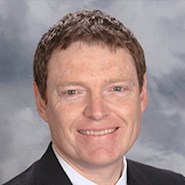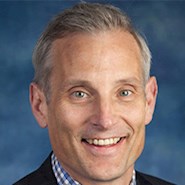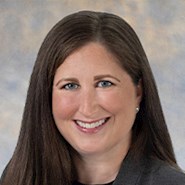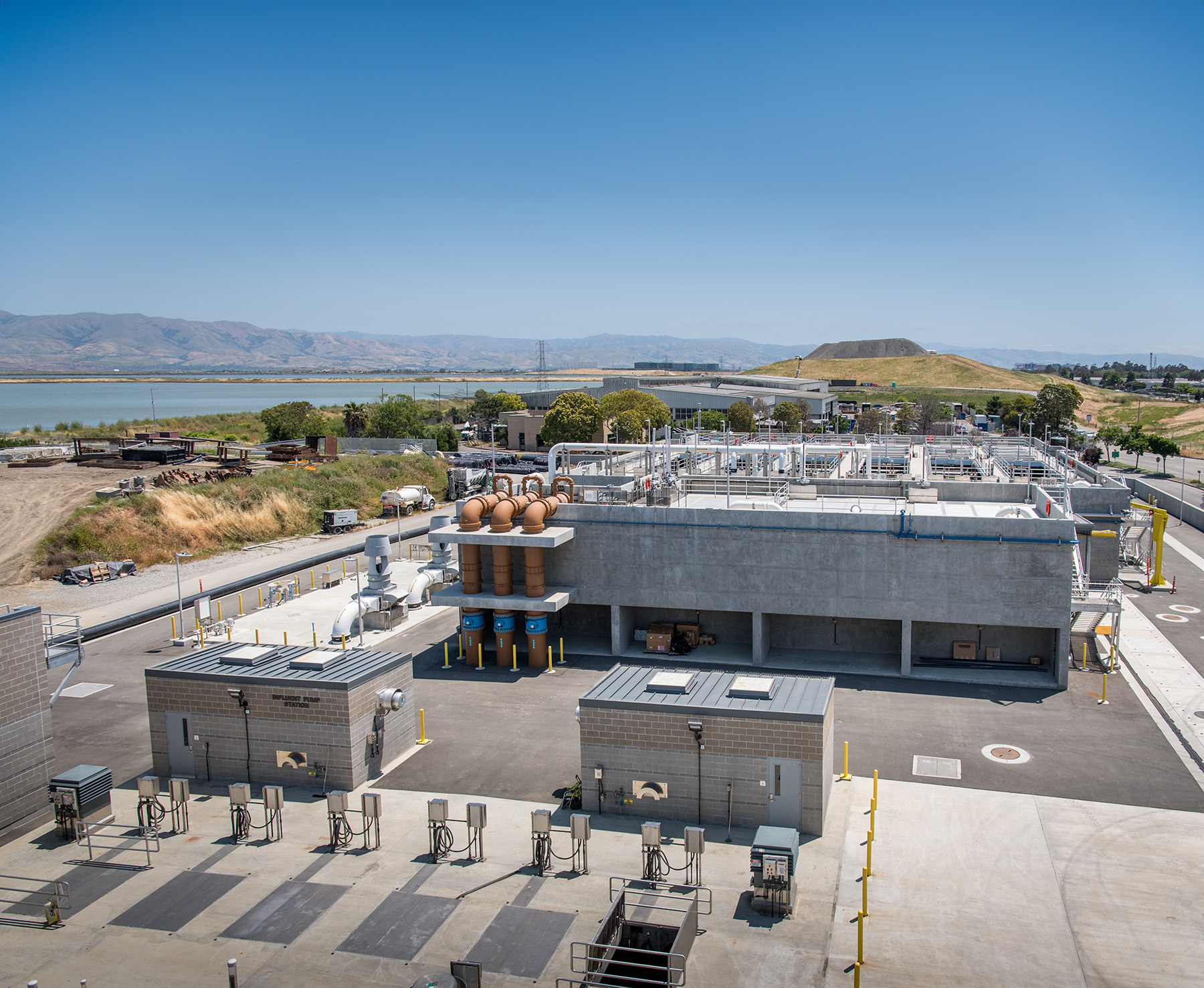
By Erin McGuire, P.E., PMP, M.ASCE, Jan Davel, Ph.D., P.E., PMP, Jim Hagstrom, P.E., and Allison Boyer, P.E.
A Sunnyvale, California, wastewater treatment plant has protected the San Francisco Bay from pollution for decades. Now, a multiphase improvement plan will also transform how it generates and uses its own energy.
In the heart of Silicon Valley in California, the City of Sunnyvale Water Pollution Control Plant treats wastewater before discharging it to the shallow waters of San Francisco Bay, which is ecologically sensitive and one of the most highly regulated bodies of water in the nation. The WPCP serves more than 160,000 residents and businesses in Sunnyvale, the Rancho Rinconada neighborhood in eastern Cupertino, and Moffett Federal Airfield.
Aside from engaging in advanced wastewater treatment, the WPCP produces recycled water, reducing demand on the potable water supply, and generates renewable energy. Over the next 20 years, the city will take advantage of low-cost financing from the Clean Water State Revolving Fund and the Water Infrastructure Finance and Innovation Act to acquire the latest technological innovations, with the goal of transforming the WPCP into a highly automated resource recovery center.
When constructed in 1956, the WPCP consisted of primary treatment facilities needed to meet the regulatory requirements in the Dickey Water Pollution Act of 1949. As the population boomed, the city expanded the plant to increase capacity. In the 1960s, it purchased ponds from the Leslie Salt Co. (now Cargill) to naturally treat the primary effluent and avoid depleting oxygen in the bay’s aquatic ecosystem. In the 1970s, the Clean Water Act prompted the construction of additional treatment processes to improve effluent quality. In 1984, the primary treatment facilities and chlorine contact tanks were refurbished and expanded. No other major facility changes were made until recently.
Master planning begins
In 2013, the city began to develop a master plan to serve as a long-term road map for systematically improving the WPCP’s facilities. The city had a number of goals: replacing the primary treatment components, which were past the end of their economic lives; updating/replacing the plant’s treatment process components (secondary and tertiary); and implementing sustainability measures, including increasing power generation and efficiency and turning waste products into usable resources — all in the most economically viable way to offset the capital costs of the master plan.
In 2016, the city adopted a five-phase master plan comprising 34 projects to be completed over a 25-year period — known as the Sunnyvale Cleanwater Program.
The city engaged CDM Smith, an engineering and construction firm, as the prime program management consultant to handle community outreach and provide program controls and financing support. The firm also provided third-party expertise for managing condition assessment, design, permitting, commissioning, and automation. Due to severe deterioration and seismic vulnerability in the existing primary treatment facilities, the city procured fast-tracked replacement designs to be developed on a concurrent schedule with the remainder of the master plan. Carollo Engineers is the prime consultant that prepared the master plan and new primary treatment facilities design. Psomas, a construction management and engineering consulting firm, is the construction manager.
Phase 1: upgrading primary treatment
The WPCP site is bordered by closed landfills, Moffett Channel (a tidal waterway), a public road leading to a regional trail, West Channel (a flood-control waterway), and an open-trench stormwater ditch. Within those borders, treatment facilities occupied the entire space. Creating an area for new primary equipment required replacing open-air sludge drying beds with an interim compact, skid-mounted mechanical dewatering and solids off-haul complex; demolishing an emergency sludge storage lagoon; and filling the stormwater ditch and replacing it with three 66 in. diameter culverts that snake through the site. Additionally, 0.7 acres of new riparian and wetland habitat were planted with native species to mitigate long-term damage to the natural environment.
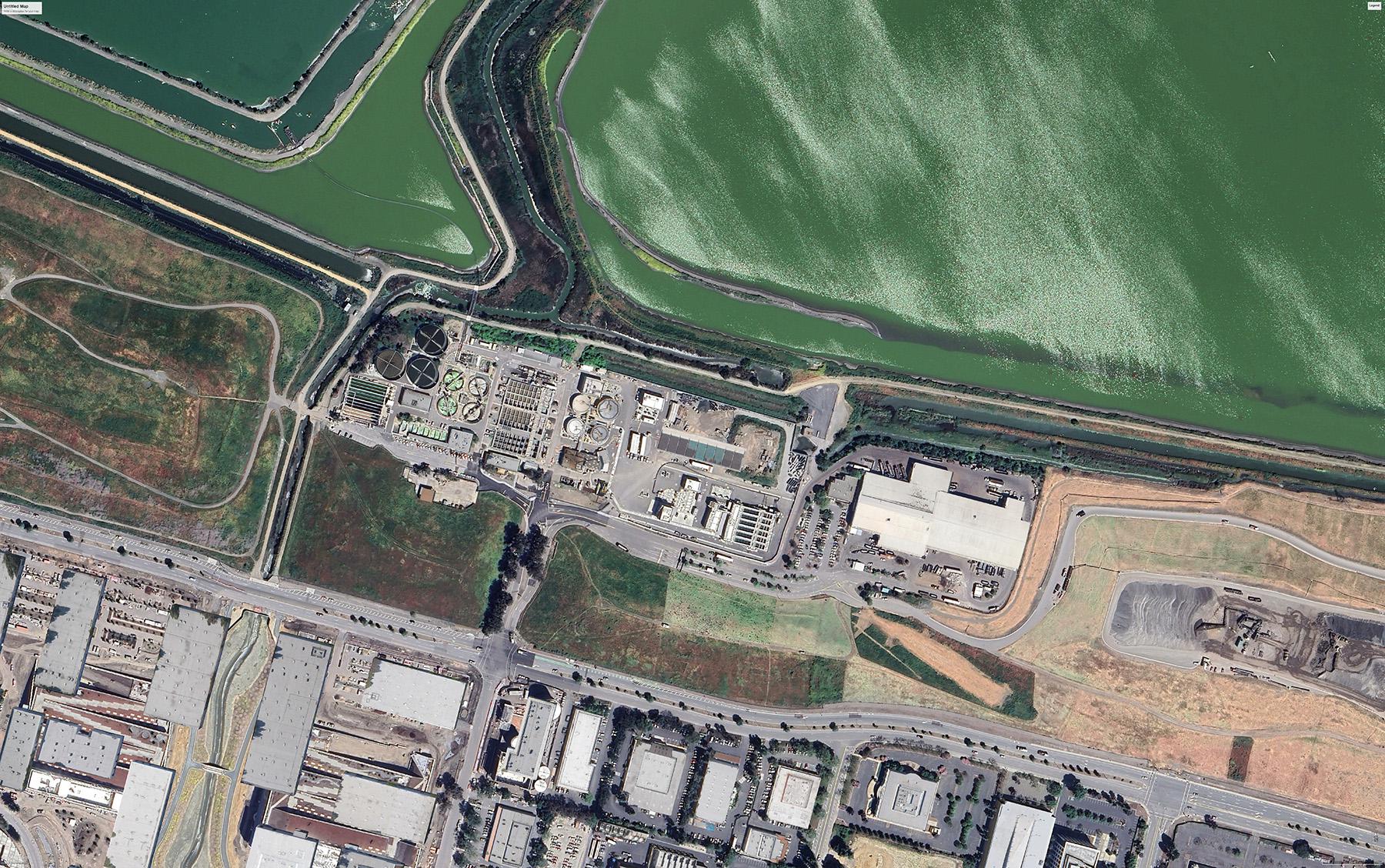
The existing primary treatment facilities consisted of pre-aeration tanks and clarifiers. These two units were structurally separate but connected by an array of pipes that could have ruptured during a seismic event. The units also lacked screens, exposing the influent pumps to debris that damaged and reduced the capacity of the sludge digesters.
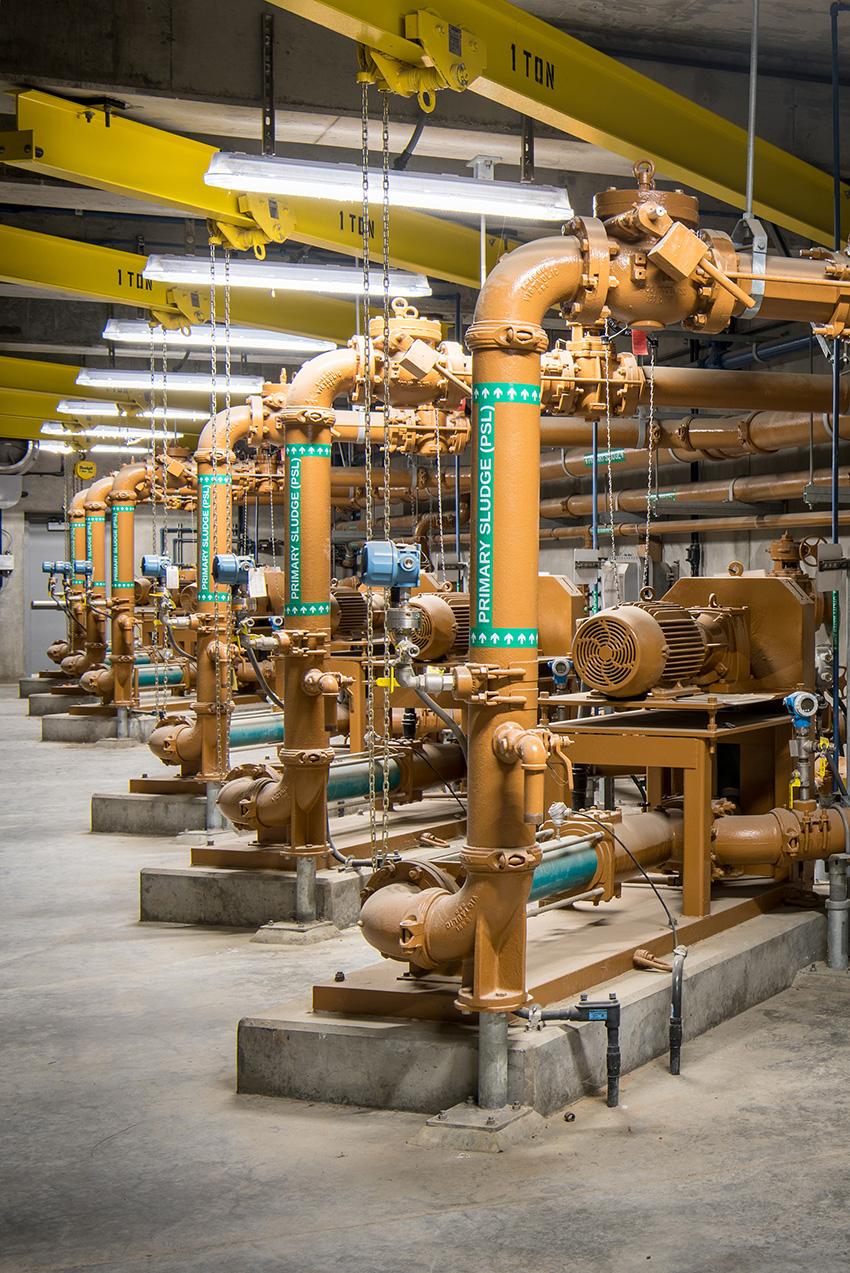
The new headworks, where wastewater enters the plant, has screening, pumping, and grit removal functions. A grit characterization study revealed large and unusually slow-settling grit with high organic content. So, the city chose a Hydro International Eutek HeadCell system that more efficiently and completely removes grit, along with high-efficiency HUBER Coanda grit washers that also remove organic matter from the grit.
The price of this equipment was pre-negotiated, standardizing line-item costs across bidders and allowing the city to compare costs to similar installations.
The new primary equipment includes six large sedimentation tanks, each equipped with a chain and flight sludge collector and sludge hopper, a shared pair of sludge pumps, return flight skimmers, a shared pair of scum pumps, and dilution fans by Strobic Air Technologies for odor control.
An integral primary influent distribution channel keeps organic solids in suspension and provides partial flocculation of suspended matter. This improves overall suspended solids and biological oxygen demand removal efficiency by reducing the portion of solids that typically do not settle well and increasing the settling velocities of solids that do.
The city minimized programmatic costs by considering primary and secondary treatment holistically. The six sedimentation tanks allow for a slower overflow rate, which increases solids removal in primary treatment. The tanks also reduce biological loading in secondary treatment, which enables smaller secondary processes to effectively treat the influent.
The city also jar-tested solids removal processes during the conceptual design phase, which provided the data for computational fluid dynamics modeling of the sedimentation tanks. The fluid dynamics model was coupled with a biological loading model of the future secondary treatment facility. The optimized overflow rate nearly doubled hydraulic loading relative to the existing facilities, and a three-day sedimentation experiment verified higher loading would not degrade performance.
Protecting the WPCP and all the improvements from flooding was both a priority and a permit requirement. The WPCP is vulnerable to storm flooding from the West Channel and tidal flooding from Moffett Channel. The team designed flood mitigation measures that include:
- A perimeter wall to retain up to 12 ft of soil and withstand wave action during a 100-year flood.
- Hydrostatically actuated pop-up gates that stay down under normal conditions.
- Vinyl sheet piles driven 20 ft below sea level to prevent seepage.
Phase 1 challenges and testing
A major challenge occurred during sheet pile installation for the perimeter wall. When using 92 tons of force (the maximum amount the control rig could generate with its hammer), the piles could not penetrate ground materials, bending both sides of the steel mandrels’ tips in opposite directions. Geotechnical borings performed after these attempts showed a previously unidentified band of very dense clay sufficient to restrict groundwater flow and provide wall stability. Crews were forced to hand-dig at numerous installation points, some as shallow as only 3 in. down.
A second challenge was determining how to support the 37 ft deep influent pump station’s 4,500 psf load on native soils comprised of compressible clay. To pre-consolidate the soils before installing the pump station, the contractor added a 10 ft deep layer of soil on top of new permanent fill. The contractor also installed and regularly monitored settlement plates until consolidation reached 90%. When that happened, the city granted final completion to Anderson Pacific Engineering Construction Inc., the general contractor that constructed the first work package, which included drying bed demolition, site reconfiguration, and soil pre-consolidation. Overaa Construction constructed the second work package, which included the new headworks and primary facilities and all ancillary work.
Construction was delayed when upgrading the electrical service feed. As part of the primary project, the existing gas-fueled influent pump engines were replaced with electric ones. While this switch helped the city achieve its decarbonization goals and compliance under a local air district agreement, the new pumps increased electric loads, sparking a yearlong major coordination effort between Overaa and the electric service provider. However, before upgrades could be completed to support the increased electric loads, technicians discovered relay setting incompatibilities that needed to be resolved, which took an additional year.
Furthermore, during quality-control testing over the following year, when Overaa relocated transformers in the main breakers, it had to pause due to persistent, unexpected tripping. The service provider was forced to replace its equipment before Overaa could finish. Post-energization testing was completed in March 2022.
As part of phase 1, in July 2023, the contractor hydraulically tested the new primary system with tertiary-treated effluent circulating through the new facilities. Automated control programming and troubleshooting continued over the following months. During this commissioning period, raw sewage entered the WPCP through an influent junction box inserted into the sewer just upstream of the existing influent pump station. Lifting a slide plate in this junction box diverted flow to the new primary system, starting a 45-day observation period. Throughout this time, the existing primaries stood by, ready to resume treatment should the new primary system malfunction. As of publication time, there had not been any malfunctions serious enough to stop testing.
Phase 2: secondary treatment development
After the new primary treatment systems passed their observation period, Ranger Pipelines Inc., the contractor for the site preparation package that kicked off phase 2, began demolishing the control building to create space for a new thickening and dewatering building. It will process the larger volumes of sludge that will be created by a conventional activated sludge, or CAS, secondary treatment facility. Ranger will also demolish and fill the decommissioned sedimentation basins and install a temporary maintenance building and modular office trailers in their place. The trailers will house staff displaced from the control building. Walsh Construction will build the new CAS facility and the thickening/dewatering building.
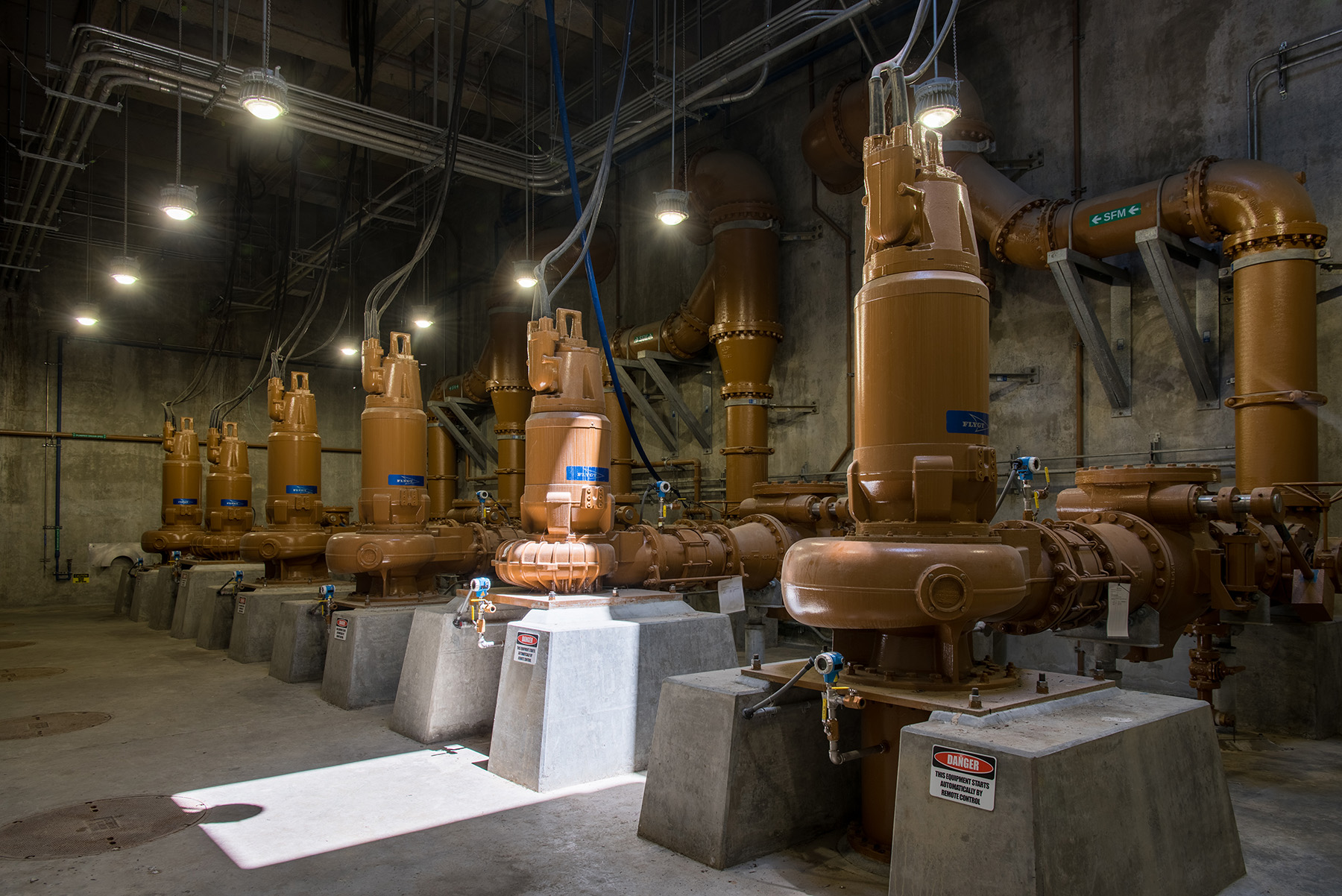
The CAS facility will consist of bioreactors configured as a Modified Ludzack-Ettinger nutrient removal system and secondary clarifiers, which will allow the city to meet more stringent effluent nutrient limits set by the San Francisco Bay Regional Water Quality Control Board.
In keeping with the city’s objective to maximize the useful life of existing facilities, Walsh will also rehabilitate the existing secondary and tertiary process so that they can continue operating until escalating regulatory requirements surpass their performance capabilities. The existing 412-acre oxidation ponds provide secondary treatment, flow equalization, and emergency storage and will supplement capacity in the new CAS facility, particularly during high flows. This enables consistent flow in a process that is sensitive to variability, preserves existing wet weather management capabilities, and allows the city to defer investment in a larger CAS system that will eventually be required to treat all flow.
Anticipating phases 3-5
As Sunnyvale’s population grows, more primary effluent will flow through the oxidation ponds’ treatment train while the amount flowing through the CAS system will remain constant. Over time, this will cause the quality of the blended effluent to decline. The oxidation ponds’ treatment effectiveness could be at risk long term because of accumulating sludge, uncontrollable blooms of blue-green algae, and stress on the ponds. In a move that will further stress the oxidation ponds, the city recently adopted urban plans that will see the sewershed’s population grow by 30%, which will accelerate capacity pressures well beyond the growth Sunnyvale’s 2016 master plan anticipated. Therefore, phases 3-5 of the program may begin sooner and include larger upgrades to accommodate the increased demands.
Fortunately, phases 1 and 2 are set up for intensification measures in two ways. First, the new primary treatment facility includes provisions for use of ferric chloride and polymer for chemically enhanced primary treatment during high loading conditions. Jar-testing and computational fluid dynamic modeling revealed Sunnyvale’s optimal chemical dosage to be 20 mg/L, twice the common rate.
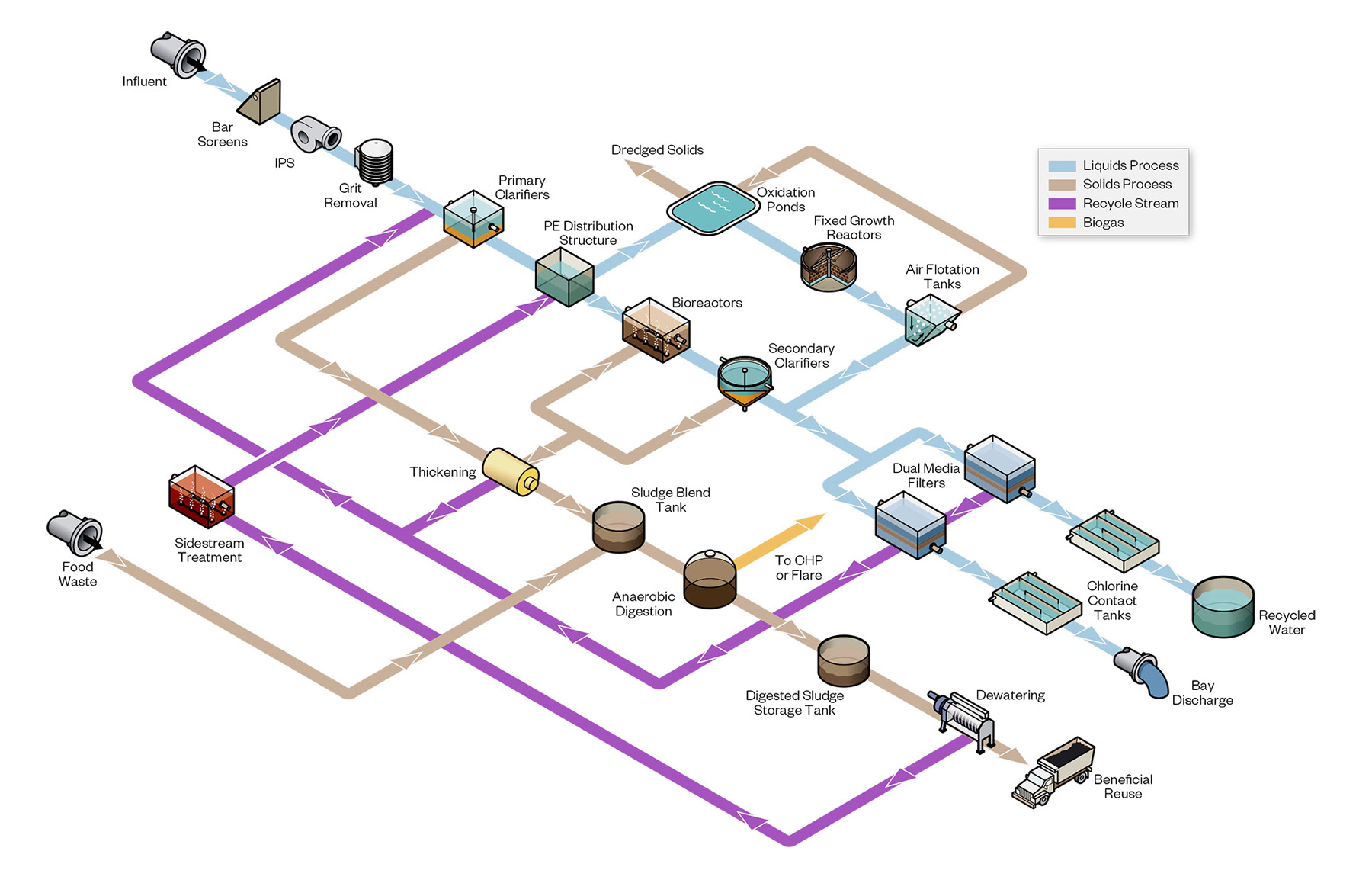
Second, the new thickening/dewatering facility will send its high-ammonia filtrate to a granular deammonification sidestream treatment process system to remove nitrogen before pumping it to the mainstream CAS bioreactors. Adding hydrocyclones on the waste-activated sludge line retains granules from the treatment system that may have slipped through to the mainstream process, thereby helping increase the secondary treatment capacity without adding more tanks.
One of the larger upgrades for phases 3-5 that will address this increase in usage will be digestion capacity. The WPCP has four anaerobic digesters that decompose primary sludge into stabilized biosolids and biogas. When the new CAS facility comes online, thickened waste-activated sludge will blend with primary sludge, increasing the total load on the digesters.
The digesters will also begin processing food waste, a move that will further increase the amount of biogas they produce. California Senate Bill 1383 requires cities to divert 75% of organic materials from landfills by 2025. Sunnyvale sends food waste slurry to an animal feed producer now, but it may lose this option as supplier competition increases. Instead, digesting this food slurry along with municipal sludge will increase the quantity and quality of biogas that currently fuels two on-site cogeneration engines that produce 1.2 MW of power on average, meeting much of the WPCP’s power demands.
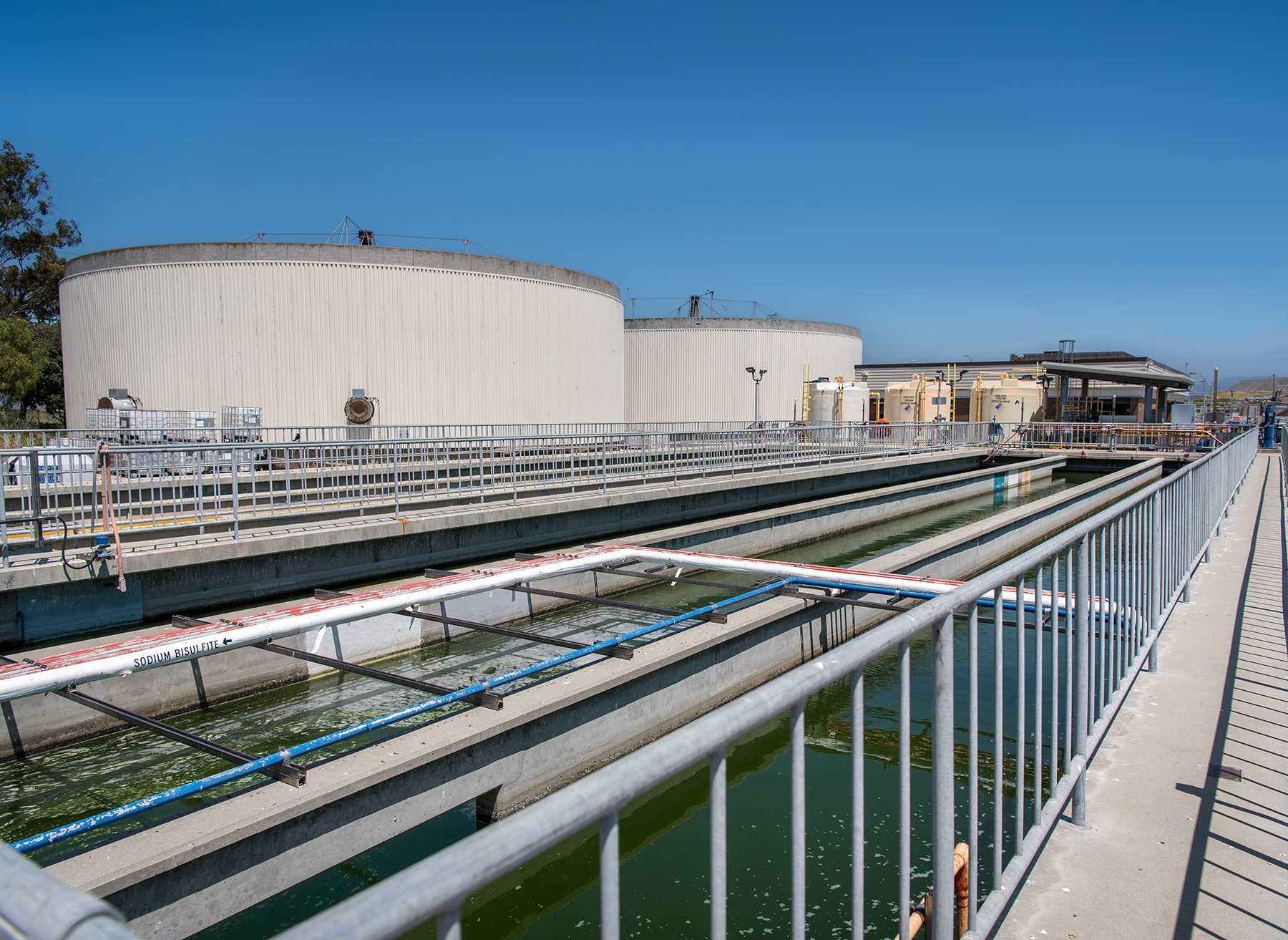
However, the cogeneration engines are aging and require extensive and costly maintenance. About 1,500 hours of unplanned downtime each year deprive the facility of more than $1 million worth of electricity as well as heat needed to operate its digesters. Additionally, if the cogeneration engines cannot process digester biogas as fuel, the city needs to flare it, creating greenhouse gas emissions equivalent to 11 million gasoline-powered passenger vehicle miles.
Responding to these challenges, environmental engineering firm Hazen and Sawyer is designing an upgrade to the cogeneration engines. In parallel, the firm is also updating the master plan so that phases 3-5 of the Cleanwater Program can accommodate changes in regulatory outlook, economic conditions, available technology, water quality, and growth projections that have emerged since the master plan was originally adopted in 2016.
At an estimated cost of $1.3 billion, the Sunnyvale Cleanwater Program is the largest, most complex capital endeavor this midsize city has ever undertaken. Sunnyvale is well positioned to accommodate any future changes as it strives to serve its community, protect the San Francisco Bay, and create a world-class resource recovery facility.
Erin McGuire, P.E., PMP, M.ASCE, is a principal and senior project manager and Jan Davel, Ph.D., P.E., PMP, is vice president and a senior project manager at CDM Smith. Jim Hagstrom, P.E., is managing director of technical practice at Carollo Engineers. Allison Boyer, P.E., is an assistant city engineer for the City of Sunnyvale.
*Funding for this project has been provided in full or in part through an agreement with the State Water Resources Control Board. California’s Clean Water State Revolving Fund is capitalized through a variety of funding sources, including grants from the United States Environmental Protection Agency and state bond proceeds. The contents of this document do not necessarily reflect the views and policies of the foregoing, nor does mention of trade names or commercial products constitute endorsement or recommendation for use.
Project credits
Owner
City of Sunnyvale, California
Program management consultant
CDM Smith, Boston
Construction management consultant
Psomas, Los Angeles
Design and engineer of record
Carollo Engineers, Walnut Creek, California
Contractors
Headworks and primary treatment package 1: Anderson Pacific Engineering Construction Inc., Santa Clara, California
Headworks and primary treatment package 2: Overaa Construction, Richmond, California
Site preparation
Ranger Pipelines Inc., San Francisco
Secondary treatment, thickening, and dewatering and existing plant rehabilitation
Walsh Construction, Chicago
Master plan update
Hazen and Sawyer, New York City
This article first appeared in the March/April 2024 print issue of Civil Engineering as “Revolutionizing Wastewater Stewardship.”




